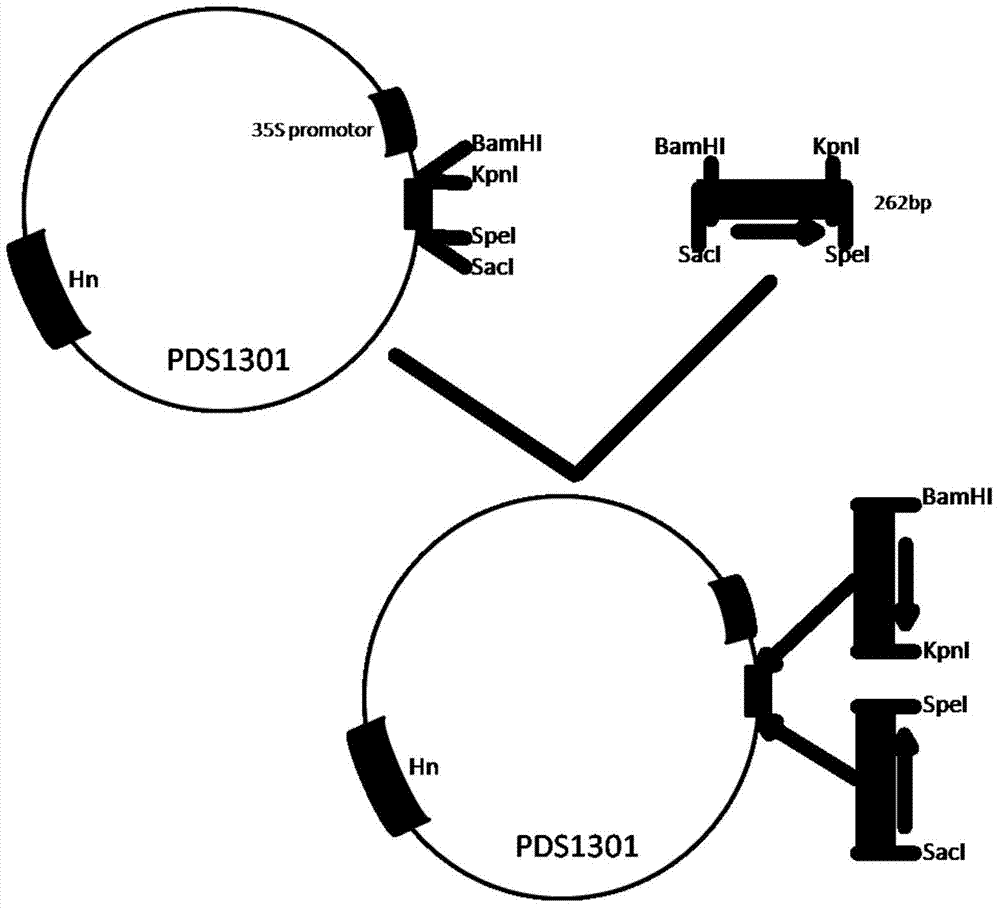Rice granule shape gene qSS7 as well as preparation method and application
A rice grain and gene technology, applied in the field of plant genetic engineering, can solve the problems of unpublished articles, shorten the breeding process and improve the accuracy
- Summary
- Abstract
- Description
- Claims
- Application Information
AI Technical Summary
Problems solved by technology
Method used
Image
Examples
Embodiment 1
[0052] Preparation method of gene qSS7:
[0053] (1) Extract the DNA of Cypress (from the International Rice Research Institute, number: IRGC117282), and use primer qs2 (left primer: ATATCATACTTATATGGCA, right primer: GACAAGTGGCTATGCTGTAT) to perform polymerase chain reaction (PCR), PCR program: 94 ° C Pre-denaturation for 5 minutes; 35 cycles (denaturation at 94°C for 40 seconds; annealing at 55°C for 40 seconds; extension at 72°C for 8 minutes), and extension at 72°C for 10 minutes; the full-length sequence of the Cypress gene was obtained by sequencing the amplified product. The sequence is Shown in SEQ ID NO.1.
[0054] (2) RNA was extracted from young panicle tissue of Cypress, and cDNA was obtained by reverse transcription. Using Cypress young ear cDNA as a template, polymerase chain reaction (PCR) was carried out with primer qs3 (left primer: AAAGGATCCATGCCTCCGGCGAGGGTGCT, right primer: AAAGGATCCTCAGCTTGTACTACTAAATG), PCR program: 94°C pre-denaturation for 5 minutes; 3...
Embodiment 2
[0057] Construction of qSS7 suppression expression vector and establishment of transformed Agrobacterium:
[0058] (1) Design markers according to the sequence of the 3' end of the japonica rice qSS7 cDNA sequence, and add BamHI, KpnI, SacI and SpeI restriction sites at the 5' end of the sequence respectively, and design the sequence of the left primer GL260MF as
[0059] AAAGAGCTCGGATCCGTTGAGGATCCACTGAATGG, the right primer GL260MR sequence is AAAACTAGTGGTACCGTGTAGTTGCTAAGCTTCCTA (primers were synthesized by Shanghai Sangon Biotechnology Co., Ltd.). Polymerase chain reaction (PCR) was carried out using Cypress young ear cDNA as template. The PCR reaction program was pre-denaturation at 94°C for 5 minutes; 35 cycles (denaturation at 94°C for 30 seconds; annealing at 55°C for 30 seconds; extension at 72°C for 40 seconds), and extension at 72°C for 7 minutes to obtain the target fragment.
[0060] Ligate the fragment to the vector. The method is: perform double digestion with ...
Embodiment 3
[0064] Agrobacterium-mediated genetic transformation of indica rice:
[0065] (1) Induction:
[0066] The seeds of mature rice material Q043 (long-grained rice material, chromosome segment substitution line containing qSS7 segment (Qiu et al., 2012)) were dehulled, and then treated with 70% ethanol by volume for 1 minute, 0.15 % concentration of mercuric chloride (HgCl 2 ) Disinfect the surface of the seeds for 15 minutes; wash the seeds 4-5 times with sterilized water; place the seeds on the indica induction medium; culture the inoculated medium in a dark place for 4 weeks at a temperature of 25±1°C.
[0067] (2) Succession:
[0068] Select bright yellow, compact and relatively dry embryogenic calli, and place them on an indica subculture medium for 2-3 weeks in the dark at a temperature of 25±1°C.
[0069] (3) Pre-cultivation:
[0070] Select compact and relatively dry embryogenic calli, put them on the indica rice pre-medium and cultivate them in the dark for 3-4 days a...
PUM
| Property | Measurement | Unit |
|---|---|---|
| molecular weight | aaaaa | aaaaa |
Abstract
Description
Claims
Application Information
 Login to View More
Login to View More - Generate Ideas
- Intellectual Property
- Life Sciences
- Materials
- Tech Scout
- Unparalleled Data Quality
- Higher Quality Content
- 60% Fewer Hallucinations
Browse by: Latest US Patents, China's latest patents, Technical Efficacy Thesaurus, Application Domain, Technology Topic, Popular Technical Reports.
© 2025 PatSnap. All rights reserved.Legal|Privacy policy|Modern Slavery Act Transparency Statement|Sitemap|About US| Contact US: help@patsnap.com



